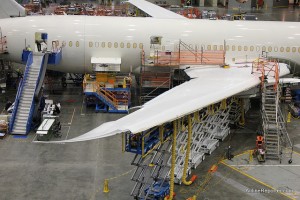Jon Ostrower on his FlightBlogger site posted a story late last night on how thousands of improperly coated fasteners inside the Boeing 787 Dreamliner’s wing need to be replaced to help protect against lightning strikes.
The FAA requires that all joints and fasteners not produce sparks around fuel after a lightening strike. Since the majority of the aircraft is made of composites, it is vunerable to arcing from one metal part to another. Boeing flies their test fleet of Boeing 787s with special anti-static additives. When the first Dreamliner, ZA001, was hit with lightening, it received no damage. 35 Boeing 787’s that have already been built which will require the re-work, which will take weeks per Dreamliner.
Check out Ostrower’s story for more information.

They may as well rename it to the “Boeing 191” given how cursed this program has been.
“Weeks per Dreamliner”? Gosh, another significant setback. I won’t say this specifically in the context of Boeing, but this is a key issue many US businesses who have made the decision to offshore have faced. They don’t have effective control over Quality Control to institute changes in the most timely and effective manner. It ends up proving costly, and significant rework is required.
This issue was identified early on in the manufacturing process, but Boeing could not incorporate the required changes into the supply chain to prevent this. As such, they continued to receive parts that required rework. Now this issue manifests itself as a significant issue for Boeing as the 787 is in its certification phase, and affects the 35 planes in final assembly.
They had to have anticipated this. Did they think they would be able to skirt this issue in the certification phase?
I really hope Boeing reconsiders its approach to the development and manufacture of future aircraft. They have been inundated with problems and delays as a result of the decision to offshore key parts of the 787’s assembly.
Again a setback for the Boeing company and for the people working on the 787. Not really a big deal in terms of the technological aspect but it will mean that some delivery dates won’t be met, again!
In my opinion the many of the misfortunes in the 787 project are the result of the Boeing decision to have large parts of the aircraft made all over the world. As a consequence, when not keeping the design and production processes in control, misunderstanding and design flaws can occur as it has turned out to be that way.
Maybe Boeing can learn from EADS how to manage and produce aircraft parts by different partners in different country’s and hence cultures. Because the culture difference and consequently the way people think and work are and will be different which can and will result in misunderstandings.
I believe the 787 will be an outstanding aircraft by design, performance and also due to the fact that it has had all these different misfortunes.
It has been reviewed and redesigned in detail many times now.
Probably Boeing will reconsider it’s approach concerning future airframe development (737 replacement)and return to the all American design and build airframe.
Or, could they (Boeing and EADS) consider a joined venture with EADS for an shared B737/A320 replacement? This might be an interesting thought also in respect (market) to the Chinese, South American, Canadian and Russian B737/A320 category airframes to be build.